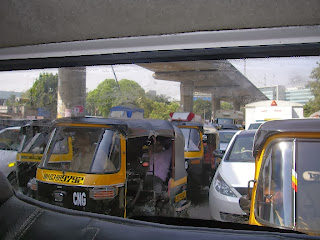The first thing that hit me when I landed in Mumbai was the heat. Tired and somewhat red-eyed, once off the airbridge from the plane door, the corridor is occupied by vast air conditioning machines from a bygone era. It isn't clear to me if they are working, because I can feel the humidity. They are building a new airport next door, because the existing one is old and too small. Once out of the airport, the taxi ride was bumpier than the worst turbulence: potholes everywhere, half-built roads, diversions, and a maze that is literally a construction site. twenty minutes later, the roads were still in a terrible state, and I started feeling queasy.
After checking in, and giving my stomach some time to rest, I took a rickshaw to a nearby shopping area. There are a quarter of a million of these little things buzzing around Mumbai like bees - three-wheeler boxes with a lawnmower engine and a cracked windscreen, weaving in and out of traffic, squeezing between a bus and an enormous truck with "Horn Please" painted on the back. Beep beep - a motorcycle zoom by, a passenger hanging on behind with no helmet on. Pedestrians jaywalk across the road as if the traffic wasn't there. Rickshaws hoot, swerve, brake, dodge, hoot again. Maybe it was pure luck that I didn't see any collisions.
What a contrast to the orderliness of the Netherlands where I was two weeks ago. I didn't see any white lines on the road here: every inch is used, and lane control is unheard of. The pavement looks like soil that was left behind after building the road. Shacks and corrugated iron buildings are everywhere ... apparently these are not the real slums, but quite respectable abodes. Once I saw the rusting frame of a "rickshaw pickup" just abandoned and quietly dying at the side of the road. Their trucks are well decorated with hand-painted signage on the front and sides, and occasionally the windscreen is outlined in tinsel.
As dusk fell, I watched the traffic from the safety of my hotel. The mad beeping traffic continued. Tuk-tuks shot round the queue and pushed in at the last moment. None of the rickshaws seem to have lights, though I saw one with indicators once.
Mumbai and the surrounding area of Maharashtra is a very beautiful place. Unfortunately, most of what I saw was the industrial area. Such are the delights of business travel. I did see some nice bits of the creek from the Airoli bridge from the taxi. One day, I might bravely venture to take a holiday here and see what India is really like ... but I might have to get used to the heat.
After checking in, and giving my stomach some time to rest, I took a rickshaw to a nearby shopping area. There are a quarter of a million of these little things buzzing around Mumbai like bees - three-wheeler boxes with a lawnmower engine and a cracked windscreen, weaving in and out of traffic, squeezing between a bus and an enormous truck with "Horn Please" painted on the back. Beep beep - a motorcycle zoom by, a passenger hanging on behind with no helmet on. Pedestrians jaywalk across the road as if the traffic wasn't there. Rickshaws hoot, swerve, brake, dodge, hoot again. Maybe it was pure luck that I didn't see any collisions.
What a contrast to the orderliness of the Netherlands where I was two weeks ago. I didn't see any white lines on the road here: every inch is used, and lane control is unheard of. The pavement looks like soil that was left behind after building the road. Shacks and corrugated iron buildings are everywhere ... apparently these are not the real slums, but quite respectable abodes. Once I saw the rusting frame of a "rickshaw pickup" just abandoned and quietly dying at the side of the road. Their trucks are well decorated with hand-painted signage on the front and sides, and occasionally the windscreen is outlined in tinsel.
As dusk fell, I watched the traffic from the safety of my hotel. The mad beeping traffic continued. Tuk-tuks shot round the queue and pushed in at the last moment. None of the rickshaws seem to have lights, though I saw one with indicators once.
Mumbai and the surrounding area of Maharashtra is a very beautiful place. Unfortunately, most of what I saw was the industrial area. Such are the delights of business travel. I did see some nice bits of the creek from the Airoli bridge from the taxi. One day, I might bravely venture to take a holiday here and see what India is really like ... but I might have to get used to the heat.








